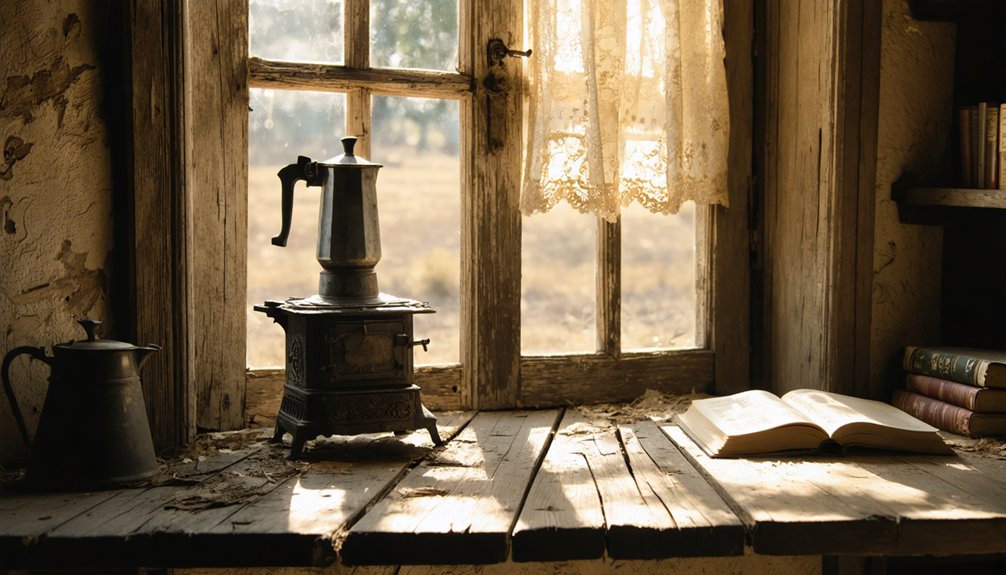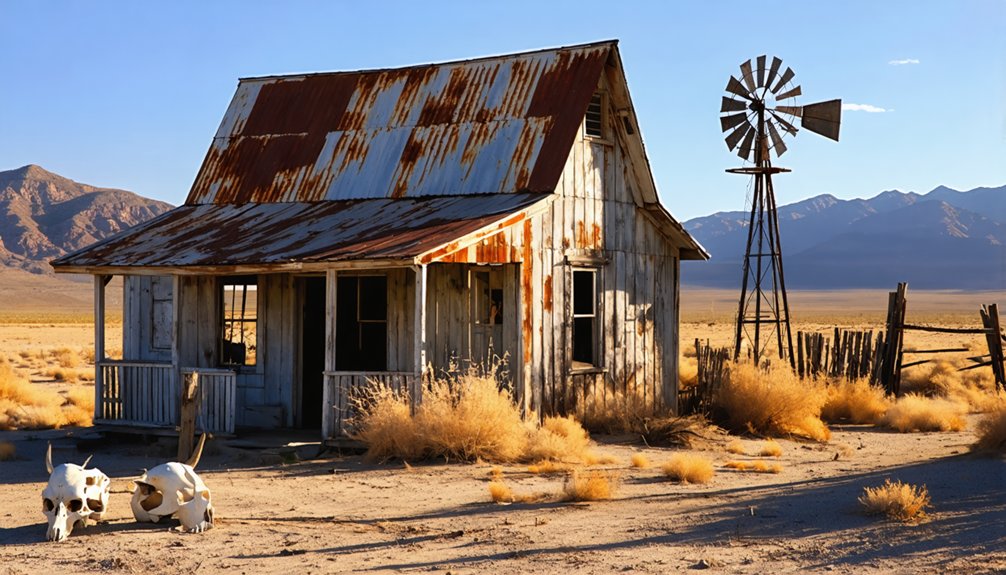You’ll find American Ranch ghost town near Prescott, Arizona, where it served as an essential stage stop along the Prescott-Hardyville toll road in 1876. The two-story hotel and trading post buzzed with travelers, from gold seekers to famous figures like the Vanderbilts and Zane Grey. While most structures have succumbed to time, you can still explore weathered ruins and a limestone kiln among desert vegetation. The site’s remote conditions and rich frontier history hold countless untold stories.
Key Takeaways
- American Ranch was established in 1876 as a stage stop along the Prescott-Hardyville toll road near Granite Mountain in Arizona.
- The site functioned as a crucial transportation hub with a two-story hotel, serving travelers, military personnel, and connecting mining camps.
- Notable visitors included the Wrigley family, Vanderbilts, author Zane Grey, and law enforcer Buckey O’Neill during its operational period.
- The ghost town declined after railroad and automobile transportation replaced stagecoaches, leading to eventual abandonment.
- Today, visitors can explore weathered ruins and limestone kilns, but must prepare for remote conditions with no facilities or cell service.
The Stage Stop Legacy
When Jefferson Harrison Lee built the American Ranch stage stop in 1876, he established what would become the most elaborate waypoint on the 150-mile Prescott to Hardyville toll road.
You’ll find his strategic choice of location near Granite Mountain reflected his pioneering vision of stage stop hospitality, expanding from his existing homestead operations in Lonesome Valley.
As part of James O. Grant’s Arizona Stage Line, the two-story hotel became a crucial transportation innovation hub, connecting Prescott to destinations like Skull Valley, Phoenix, and even San Bernardino, California.
You could count on essential services here – from mail handling to horse exchanges – though the journey itself remained perilous.
Despite robberies and harsh weather, American Ranch stood as a beacon of frontier progress, facilitating the movement of passengers and freight across Arizona’s challenging terrain.
Agnes Lee enhanced the ranch’s reputation by serving excellent home-cooked meals to weary travelers between California and New Mexico.
With 132 stage robberies reported in the Arizona Territory between 1875 and 1903, travelers faced constant threats during their journeys.
Location and Regional Significance
Three distinct geographical features defined American Ranch’s strategic location: its position near Granite Mountain, its proximity to Fort Whipple, and its placement along the vital Prescott to Hardyville toll road in Yavapai County, Arizona.
You’ll find this significant site just one mile down Granite Creek from Fort Whipple, where it served as a critical nexus for regional development.
The ranch’s position influenced settlement patterns by anchoring travel routes between mining camps and military installations. Its military significance stemmed from its role in supporting Fort Whipple’s operations, while local homesteads supplied hay and provisions to cavalry units.
Like many ghost town sites, American Ranch served as a vital transportation hub connecting remote mining camps to civilization.
Similar to Milville’s role in processing silver bullion, American Ranch acted as a crucial supply point for surrounding communities.
As the most elaborate stage stop along the 150-mile transportation corridor, it bridged the gap between frontier Arizona and civilization, facilitating the territory’s transformation from hostile wilderness to settled land.
Daily Life Along the Stagecoach Route
Life along the stagecoach route at American Ranch bustled with constant movement of travelers, crews, and local residents. You’d find yourself among diverse company at the two-story hotel, where travel experiences were shared over meals and stories exchanged about life in different territories.
Weary travelers found respite at American Ranch’s busy hotel, sharing tales of distant territories over warm meals and friendly conversation.
The property’s duck pond offered a moment of leisure during your arduous journey. A complete trip from Yuma to Mesilla required eight days of travel. The Southern Pacific Railroad arrived in 1877, bringing significant changes to transportation in the region.
Your social interactions wouldn’t be limited to fellow passengers. Local farmers, ranchers, and entrepreneurs created a vibrant trading community, supplying essential goods and services to keep the stagecoach operations running.
While you’d enjoy these conveniences, you’d also need to stay alert to potential dangers. Weather, terrain, and the threat of robbery made every journey an adventure, with stage stop owners taking precautions like building escape tunnels for everyone’s protection.
Rise and Decline of American Ranch
Although American Ranch began as a humble stage stop along the Prescott-Ehrenburg route in the late 19th century, it quickly grew into a significant transportation hub thanks to its strategic location near Castle Creek and natural hot springs.
Similar to how Castle Dome Mountains served as a transport depot, American Ranch became crucial for regional movement and commerce.
The community dynamics revolved around transient workers and travelers, with the ranch’s economy focused on providing essential services like horse changes, supplies, and shelter. The establishment featured a large hotel that served as a primary accommodation for passing travelers.
You’d have found basic infrastructure including stables and a general store, but unlike other Arizona settlements, it never developed significant mining operations.
The economic changes that led to American Ranch’s decline began with the shift from stagecoaches to railroads and automobiles.
As better roads emerged and nearby towns with rail access flourished, the once-vital stop became obsolete.
The closure of local post offices, including Catoctin’s in 1920, marked the area’s gradual descent into abandonment.
Remaining Structures and Artifacts
Today’s visitors to American Ranch encounter a stark landscape of weathered ruins, with only a handful of original structures still standing.
You’ll find the limestone kiln near the old railroad tracks, now fenced off due to its fragile condition. While exploring the site, you’ll notice scattered historical artifacts like broken window frames and door hinges among the building remnants.
The architectural features that remain paint a picture of the town’s mining heritage, including foundations of company quarters and a schoolhouse. Several structures showcase the distinctive Santa Fe style with adobe construction methods of the region. Like Ruby, Arizona’s remaining structures, many buildings require ongoing maintenance to prevent total collapse.
Near Cedar Glade, you can spot partial walls and industrial remnants of smelter operations. Fire damage has left its mark across the townsite, though some domestic artifacts survive in the ruins.
The harsh desert climate continues to erode these remaining structures, making each visit a chance to witness history slowly fading away.
Transportation Hub of the Old West
American Ranch served as one of four major transportation hubs in late 19th-century Arizona, strategically positioned at the crossroads of essential stagecoach routes and wagon trails.
You’ll find its legacy in the complex freight logistics that connected mining camps, ranches, and emerging towns like Tombstone and Benson. Every 10 miles along these routes, stops provided fresh horses and rest for weary travelers facing transportation challenges like bandits and treacherous terrain.
When the Southern Pacific Railroad arrived, American Ranch adapted, becoming a crucial transfer point between rail shipments and local deliveries.
Prairie schooners capable of hauling six tons of cargo made regular stops here, while skilled teamsters, blacksmiths, and horse handlers kept the wheels of commerce turning in this bustling frontier crossroads.
Notable Travelers and Historical Accounts

During the late 1800s, travelers from diverse backgrounds made their mark at American Ranch, transforming this remote outpost into a vibrant crossroads of frontier life.
You’d find an intriguing mix of gold seekers, cattlemen, and territorial officials passing through, while cultural clashes between Anglo settlers, Mexican laborers, and Native Americans shaped the social landscape.
Among the famous visitors to the region were wealthy families like the Wrigleys and Vanderbilts, who ventured to nearby resorts and hot springs.
The ranch’s strategic location on the Prescott-Ehrenberg route drew notable figures like author Zane Grey and law enforcer Buckey O’Neill.
Philip Varney’s historical accounts capture the essence of this period, documenting power struggles and violent encounters that typified life at American Ranch.
Modern Ghost Town Experience
While the historical echoes of stagecoach wheels and frontier conflicts have faded, visitors to American Ranch now encounter a raw, untamed ghost town experience that speaks to the impermanence of frontier settlements.
This remote destination has become a magnet for urban exploration enthusiasts seeking authentic abandoned places untouched by modern development or tourist infrastructure.
Your journey through American Ranch’s weathered ruins offers:
- Unfiltered access to crumbling foundations and walls overtaken by desert vegetation
- Photography opportunities capturing the stark beauty of frontier abandonment
- Complete solitude among historical remnants, with only desert wildlife as company
You’ll need to navigate unpaved roads and bring essential supplies, as there’s no cell service or facilities.
The site’s privately owned status and lack of preservation measures mean you’re witnessing history in its natural state of decay.
Frequently Asked Questions
Were Any Notable Gunfights or Criminal Incidents Recorded at American Ranch?
You won’t find gunfights or criminal incidents in American Ranch’s history books – historical records show it remained peaceful, unlike more notorious Arizona locations where outlaws and lawmen clashed regularly.
What Native American Tribes Inhabited the Area Before American Ranch’s Establishment?
You’ll find the Hohokam and Apache tribes originally dominated this area’s cultural heritage, with the Tohono O’odham also maintaining significant presence before European settlement changed the region’s native dynamics.
Did Any Famous Outlaws or Lawmen Frequent This Stagecoach Stop?
While stagecoach robberies occurred nearby, you won’t find records of famous outlaws or lawmen legends at this stop. It served mostly as an upscale waypoint for regular travelers and businessmen.
What Was the Average Cost for Travelers to Stay Overnight?
You’d have paid between $1-$3 per night for basic lodging options at this frontier stop, with overnight rates varying based on whether you wanted meals or just a simple bed.
Were There Any Significant Natural Disasters That Affected American Ranch?
You won’t find records of significant natural disasters impacting American Ranch. While nearby areas experienced flash floods and environmental challenges, there’s no historical documentation of major catastrophes affecting this stage stop.
References
- https://en.wikipedia.org/wiki/American_Flag
- https://www.arizonahighways.com/article/arizona-ghost-towns
- https://azgw.org/yavapai/ghosttowns.html
- https://www.azcentral.com/story/news/local/arizona-history/2025/04/02/7-uniquely-arizona-ghost-towns/81809788007/
- https://www.visitarizona.com/like-a-local/5-arizona-ghost-towns-you-may-have-never-heard-of
- https://www.hipcamp.com/journal/camping/arizona-ghost-towns/
- https://en.wikipedia.org/wiki/List_of_ghost_towns_in_Arizona
- https://www.youtube.com/watch?v=lupQkQ_tXoc
- https://janmackellcollins.wordpress.com/2020/04/15/whats-in-a-name-yavapai-county-arizona-ghost-towns-vary-from-whimsical-to-wondrous/
- http://prescottazhistory.blogspot.com/2017/07/the-american-ranch-ritz-of-stage-stops.html



